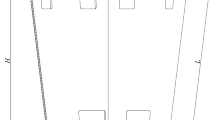Abstract
Large cracks may occur in the pressured module under the impacts of micro-meteors and space debris during orbit, which may cause rapid instable extension of cracks under the internal pressure load. To reduce the risk, the design criterion of crack stop is put forward, and the mechanism of fracture extension, simulation analysis and test verification method are studied. At the same time, the critical crack length and the influence of different parameters on it are obtained by the analysis and test of a typical integrally stiffened structure. It is proved that the structure design of the integrally stiffened structure for a spacecraft has a good crack stop performance.







Similar content being viewed by others
References
Lutz B, Williamsen J (1996) Critical fracture of space station modules following orbital debris penetration. In: 1996 AIAA Space Programs and Technologies Conference, September 24–26, Huntsville, AL
Chen TX, Zhang L, Zhao CX et al (2014) The technique of integrally stiffened structure for Tiangong-1 pressurized module (in Chinese). Sci China Tech Sci (Chin Ver) 44:150–161. https://doi.org/10.1360/092014-7
Fu H, Ma X (2004) Life controle mthod for pressure vessel. J Mech Strength 26(5):506–509
Lixing HUO (2000) Fracture behavior and assessment of welded structures. Mechanical Industry Press, Beijing
Hou CL, Li X, Pan R (2009) Comparison and analysis of calculation methods used in different codes concerning impedance function of foundation for nuciear power piants. Nuclear Power Eng 30(3):1–3
Zhai GD, Liu ZD, Po D (2007) Fatigue fracture analysis of pressure vesscl with cracks. J Architect Civ Eng 24(3):87–90
Jianwei SHI (2016) Study on fatigue crack growth of stiffened metal panels. Aeronautical Sci Technol 27(8):54–57
Ahmed A, Bakuckas JG et al (2007) Fatigue testing of a stiffened lap joint curved fuselage structure. J Aircr 44(3):750–757
Acknowledgement
The authors would like to thank the company Beijing Institute of Spacecraft System Engineering (ISSE) for the supporting on the research. Meanwhile We are grateful to the editor and anonymous reviewers for their constructive.
Funding
The paper has not disclosed any funding.
Author information
Authors and Affiliations
Contributions
Shi Wenjing put forward the design criterion of crack stop and designed the experiment. Shi Liming is responsible for the mechanism of fracture extension and the simulation analysis. Zhang Lin performed the experiments. All Authors read and approved the manuscript.
Corresponding author
Ethics declarations
Conflict of interest
The authors declare that they have no conflict of Interest.
Ethical approval
This article does not contain any studies with human participants performed by any of the authors.
Informed consent
For this paper, no informed consent is required.
Rights and permissions
About this article
Cite this article
Shi, W., Shi, L. & Zhang, L. Research on Crack Stop Characteristics of Integrally Stiffened Structure for Spacecraft Pressured Modules. Adv. Astronaut. Sci. Technol. 5, 219–225 (2022). https://doi.org/10.1007/s42423-022-00116-6
Received:
Revised:
Accepted:
Published:
Issue Date:
DOI: https://doi.org/10.1007/s42423-022-00116-6




